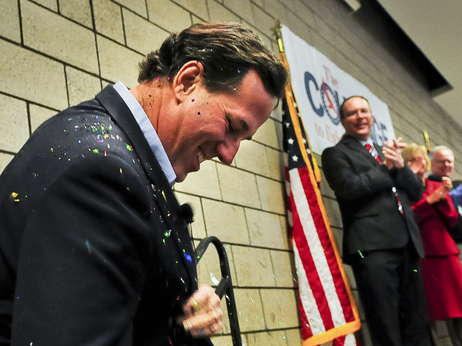From the Blog Social (In)Queery
http://socialinqueery.com/2012/03/08/glitterbomb/
Social Data for the Queer Revolution…

Glitter-Bombing: Tactical Frivolity or a Frivolous Tactic?
 The first time I remember glitter being used as an educational tool, I was in elementary school. All of the first through third graders were gathered in the auditorium. At the front of the room, an adult shouted for everyone to be quiet. She reached into a paper bag and pulled out a handful of gold glitter and asked for a volunteer. My hand shot up immediately. But she chose someone else. Asked if we liked glitter, we all screamed “YES!” in unison, and then she said, “Well not today!” I like to think that there was a dramatic pause here as we all gasped, but that may be how I like to remember the story. She let the glitter sprinkle back into the bag, but her hand was still covered. She asked the boy who volunteered to shake her hand and so he did. Then she got all of us up and asked us to walk around the room shaking hands with people. As you might expect, this got rowdy (as random handshaking parties are wont to do) and she stopped us all after five minutes or so. “Raise your hand if it has glitter on it,” she said. Almost all of us raised our hands. Then we all sat down and she talked at length about germs and diseases and the importance of basic hygiene.
The first time I remember glitter being used as an educational tool, I was in elementary school. All of the first through third graders were gathered in the auditorium. At the front of the room, an adult shouted for everyone to be quiet. She reached into a paper bag and pulled out a handful of gold glitter and asked for a volunteer. My hand shot up immediately. But she chose someone else. Asked if we liked glitter, we all screamed “YES!” in unison, and then she said, “Well not today!” I like to think that there was a dramatic pause here as we all gasped, but that may be how I like to remember the story. She let the glitter sprinkle back into the bag, but her hand was still covered. She asked the boy who volunteered to shake her hand and so he did. Then she got all of us up and asked us to walk around the room shaking hands with people. As you might expect, this got rowdy (as random handshaking parties are wont to do) and she stopped us all after five minutes or so. “Raise your hand if it has glitter on it,” she said. Almost all of us raised our hands. Then we all sat down and she talked at length about germs and diseases and the importance of basic hygiene.  I think it was a lesson about health and hygiene generally, but I now like to think that it was sex education in disguise, and that the “handshake” was a metaphor. Either way, I will say this: I sometimes think about the exercise when I wash my hands (and when I don’t). If you’ve never had glitter all over you, take it from me, it doesn’t come off after the first wash.
I think it was a lesson about health and hygiene generally, but I now like to think that it was sex education in disguise, and that the “handshake” was a metaphor. Either way, I will say this: I sometimes think about the exercise when I wash my hands (and when I don’t). If you’ve never had glitter all over you, take it from me, it doesn’t come off after the first wash.
The educational properties of glitter have been put to other uses more recently as well. Glitter-bombing has become a phenomenon across the nation as a way of peacefully and playfully protesting political pundits and candidates that support a particular constellation of anti-gay agendas. Glitter-bombing is a new form of protest that’s been directed at virtually all of the GOP candidates for this presidential race. The sentiment dates back to when the former-Miss-Oklahoma-turned-anti-gay-rights-activist, Anita Bryant, had a pie thrown in her face at a press conference.
 Today, protestors throw a handful (and sometimes more) of glitter on politicians–often as they are walking to the podium to deliver a speech. Forced to negotiate this awkward turn of events, candidates regularly attempt to address the glitter (some more successfully than others). Glitter bombers target those with anti-gay views, candidates who oppose gay marriage, and more.
Today, protestors throw a handful (and sometimes more) of glitter on politicians–often as they are walking to the podium to deliver a speech. Forced to negotiate this awkward turn of events, candidates regularly attempt to address the glitter (some more successfully than others). Glitter bombers target those with anti-gay views, candidates who oppose gay marriage, and more.
So, here’s my question: what is glitter-bombing accomplishing? And by that, I mean what is it accomplishing aside from being absolutely hilarious and fantastic? Is this a strategy of protest we ought to support?
I’ve never read any academic research on glitter-bombing, but I’ve written on drag before (here), and I think that the conversation on drag has much to offer our understanding of the social and political consequences of glitter-bombing. Feminists typically come down on one of two sides when discussing performances of drag: it’s framed as either deconstructing gender boundaries (see here, here, here, and here) or as reproducing them (see here, here, here, and here)–depending on your perspective.
Similarly, we have two choices with glitter-bombing.
(1) Tactical Frivolity: Glitter-bombing as a Performance of Protest?
We can take glitter-bombing seriously and treat it as a significant piece of the tactical repertoire of contemporary GLBT activism. GLBT activism has long utilized a politics of carnival to make its issues heard. This kind of tactical frivolity relies on humor, performativity, and non-compliance. And it’s also true that civic engagement of all kinds is taking on new forms, making political action and inaction more difficult to measure and define (see here). Political action, protest, and participation look different here, but it is precisely this celebration and acknowledgement of difference that glitter-bombing promotes. Nick Espinosa (self-proclaimed originator of the glitter-bomb) states it this way:
 “What I have tried to do with creative forms of protest like glittering is to capture people’s imagination and tap into a cultural point of reference with a piece of political theater projected into the real world. By creating a moment of conflict I shine a light onto the hypocrisy and bigotry of our current political discourse in a way that is as entertaining as it is dramatic.” (here)
“What I have tried to do with creative forms of protest like glittering is to capture people’s imagination and tap into a cultural point of reference with a piece of political theater projected into the real world. By creating a moment of conflict I shine a light onto the hypocrisy and bigotry of our current political discourse in a way that is as entertaining as it is dramatic.” (here)
In this line of thinking–similar to the ways that Taylor, Rupp, and Gamson discuss drag–perhaps glitter-bombing too can be understood as part of the “tactical repertoire” of the gay and lesbian movement in the U.S.; it is here seen as a dramatic “performance of protest.” To classify drag in this way, they argue that it must fulfill three requirements: it must be understood as contestation, a degree of political intentionality is necessary, and it must be involved in the promotion of collective identity. Like drag, glitter-bombing fulfills these three criteria as well. But is glitter-bombing best understood as tactical frivolity?
(2) Frivolous Tactics: Glitter-bombing as Promoting Stereotypes that Perpetuate Inequality?
Similar to discussions of drag, some scholars argue that performances of drag highlight just how socially constructed gender is (“tactical frivolity”), while others claim that performances of drag serve primarily to reinforce stereotypes that have their origins in systems of power and inequality (“frivolous tactic”). While glitter-bombing may be an example of tactical frivolity, few bombers seem to stop to ask whether it might be a frivolous tactic. This would involve considering the possibility that the act might actually work against the intentions of glitter-bombers.
As Espinosa later states, “As I have learned, creating a spectacle effectively engages the 24-hour news cycle and gives an opportunity to embed a succinct message in that moment. Social networks like Facebook and Twitter allow a short YouTube clip to go viral and reach audiences we would have never imagined” (here). Glitter-bombing certainly creates a spectacle, and Espinosa was right that it’s one that has gone viral, perhaps reaching populations that might not otherwise be reached. What he has less control over, however, is how that spectacle is framed in the media (though he has attempted to ensure that his political intentions are clear). And beyond that, glitter-bombers do not necessarily know how people will make sense of this act even if their intentions are clear.
Alongside politicians’ attempts to have glitter-bombing legally classified as a form of “assault” (citing the dangers of inhalation or getting in people’s eyes), there has also been a more violent reaction with groups of conservatives calling for a violent response to glitter-bombers. Could glitter-bombing be simply promoting a set of stereotypes about homosexuality that have their origins in systems of power and inequality? It’s what Josh Gamson refers to as a “queer dilemma.”
 I don’t have an answer as to what glitter-bombing is actually accomplishing, but I do think that we need to at least acknowledge that it might not be doing what we’re hoping it’s doing. For now, however, I’m happy thinking about GOP candidates trying in vain to remove all the glitter when they’ve been successfully bombed. Ever since my elementary school assembly using glitter to explain germs, I’ve never been able to fully shake the association. Perhaps sprinkling glitter all over a group of people who see homosexuality as a form of social contagion is exactly what we should be doing.
I don’t have an answer as to what glitter-bombing is actually accomplishing, but I do think that we need to at least acknowledge that it might not be doing what we’re hoping it’s doing. For now, however, I’m happy thinking about GOP candidates trying in vain to remove all the glitter when they’ve been successfully bombed. Ever since my elementary school assembly using glitter to explain germs, I’ve never been able to fully shake the association. Perhaps sprinkling glitter all over a group of people who see homosexuality as a form of social contagion is exactly what we should be doing.
—
Tristan Bridges is currently a lecturer at the University of Virginia in the Sociology department and the Studies in Women & Gender program. He will be starting as an Assistant Professor in the Sociology Department at SUNY College at Brockport in the fall of 2012. His research considers the many ways that men think about, reproduce, and resist gender and sexual inequality. He is currently investigating the historical roots of “man caves” in heterosexual couple households and examining the ways that men and women make sense of these spaces in their homes. (@tristanbphd)
No comments:
Post a Comment